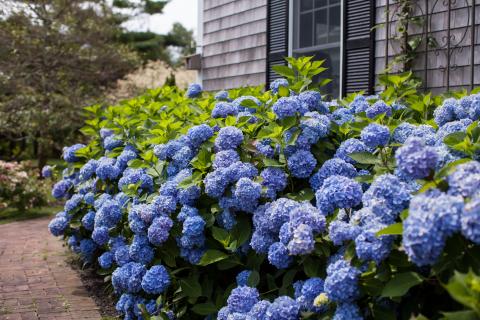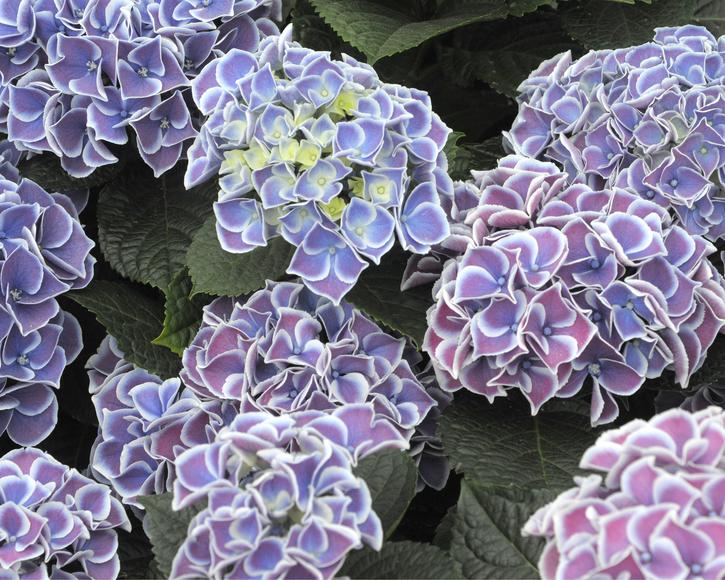Bigleaf Hydrangea, French Hydrangea
The oversized flower clusters of the Bigleaf Hydrangea make the summer bloomers a must-have for shady corners of the garden.
Factsheet
- Growth type
-
- half shrub
- Growth height (from)
- from 100 cm to 200 cm
- Growth width (from)
- from 100 cm to 250 cm
- Growth characteristics
-
- spherical
- upright
- Flower color
-
- blue
- red
- pink
- white
- Flowering time (month)
-
- June to September
- Flower shape
-
- Umbrella panicles
- Leaf color
-
- green
- page format
-
- elliptiques
- pointed
- Light
-
- scattered light to semi-shade
- Soil type
-
- sandy to loamy
- Soil Moisture
-
- humid
- ph value
-
- weakly acidic to acidic
- Lime compatibility
-
- sensitive to lime
- Nutrient requirements
-
- nutrient-rich
- Humus
-
- rich in humus
- Decorative or utility value
-
- Flower Decoration
- Toxicity
-
- weakly poisonous
- Winter Hardness
-
- conditionally hardy
- Climate zones according to USDA
-
- 4
- Use
-
- Flowerbeds
- Bouquets
- Single position
- Group planting
- Planters
- Garden style
-
- cottage garden
- Flower garden
- Rhododendron garden
- Pot garden
- Forest Garden
French or Bigleaf Hydrangeas (Hydrangea macrophylla) are the best-known representatives of the plant genus Hydrangea (Hydrangea). The flowering shrubs originate from Japan, where they have a long garden history, and became very popular around the world early on. In the 20th century, a veritable breeding boom resulted in hundreds of new varieties and hybrids. Today, the name Bigleaf Hydrangea is used both for pure varieties of Hydrangea macrophylla and various hybrids (such as Hydrangea aspera).
Bigleaf Hydrangeas are upright subshrubs with dense growth, which, depending on the variety and location, can grow up to seven ft tall and at least as wide. The summer bloomers are deciduous, but the inflorescences remain on the plant over winter after they fade. Young shoots have a green bark that later turns brownish. Thicker branches are usually light brown and have felt-like bark that peels off.
The Bigleaf Hydrangea leaves are deciduous, positioned in an opposite arrangement and sit on short fleshy stems. They have an oval shape and can grow to a length of 5.90 inches. The leaves have coarsely serrated edges, a glossy surface and a pointed end. As a rule, the leaves of the shrubs do not have a noticeable fall color.
Ihre übergroßen schirm- oder ballförmigen Blütenrispen haben der Hortensie auf der ganzen Welt viele Fans beschert. Double-flowered Bigleaf Hydrangeas are sometimes sold as Mophead Hydrangeas, but what is generally meant is the Smooth Hydrangea (Hydrangea arborescens). Mountain Hydrangeas, on the other hand, have a flattened flower head, with an outer ring of showy, but sterile flowers. They attract insects to the actual flower head in the middle of the blossom. This type of blossom is known as lacecap.
Bigleaf Hydrangeas flower all summer long from June to October with white, pink or blue blossoms, depending on the soil and variety. When pruning Bigleaf Hydrangeas, you should take into account that they will have developed their flowers the year before on one-year-old wood. Hydrangeas – especially the new Hovaria varieties – display an impressive play of colors as they fade: The flower clusters slowly change from their original color to a greenish to rusty red tone, which keeps the Hydrangea blossom going even longer from a purely visual perspective.
When it comes to soil requirements, Bigleaf Hydrangeas are specialists, because in their native Japan, they are commonly found by watercourses and damp forest edges. As a result, the flowering shrubs love low-lime, moist, humus-rich soil with a pH between 4.5 and 6. They thrive in sheltered spots with partial shade. A north or west facing location without a draft is ideal. If the Hydrangea is exposed to strong sunlight, it will need lots of water – otherwise the leaves will go limp and can even get sunburnt.
To provide the Hydrangea with the acidic substrate it needs, it is advisable to plant it in a special soil for Hydrangeas, Rhododendrons or Azaleas. Spring is the best time to plant new Hydrangeas, as the plants then have until winter to successfully establish roots. When you take the plant out of the pot, make sure to remove any roots that run around the edge, as these circling roots hamper growth. Hydrangeas should not be planted too deeply, as they have shallow root systems. The planting hole should be as deep as the Hydrangea’s pot. Water Hydrangeas thoroughly after planting.

As the name suggests (Hydrangea pretty much means ‘water slurper’), Bigleaf Hydrangeas need lots of water in summer. You should water potted plants twice a day when it is hot. It is best to fertilize the plants using a special Hydrangea or Rhododendron fertilizer with an acidic effect. It’s best to fertilize blue-flowered varieties with a Hydrangea fertilizer that contains alum. The aluminum salt encourages blue flowers. Moreover, the pH of the soil should not rise too much, otherwise the flower color will eventually turn light pink to pink – therefore only water the plants with rainwater if you want blue Hydrangea flowers. You should provide particularly large-flowered varieties with plant supports, as the stems bend slightly, especially after heavy rainfall. You should reduce the amount of water and stop fertilizing the plant towards the end of summer. This allows the branches to adequately lignify and be ready for winter. However, as is usual for subshrubs, the shoot tips will not lignify by winter.
Not all Bigleaf Hydrangeas are truly frost-hardy. Some varieties can only tolerate temperatures as low as 23 degrees Fahrenheit without protection. Others can survive harsh winters without any difficulty. Freezing back of unwooded shoot tips is normal in all Bigleaf Hydrangeas and is no cause for concern. New growth is occasionally damaged by late frosts, which usually only cause the leaves to die off, but in serious cases flowers too.
Covering Bigleaf Hydrangeas with fir tree branches or leaves during overwintering, protects them against severe frostbite. A fleece cover is recommended for severe frosts, because cold easterly winds increase the risk of Hydrangeas suffering frost damage. To maintain flowering, you can leave faded Bigleaf Hydrangea flower heads on the shrub over winter. This is not only practical, but also very decorative. Potted Bigleaf Hydrangeas should be protected to prevent the root ball from freezing. It’s best to overwinter them in an unheated garage or summer house. They can also be overwintered on the patio if you put the tubs in large wooden boxes, insulate them with leaves and move them close to a sheltered wall of the house. It’s best to completely cover the shrubs themselves with fleece.

For Bigleaf Hydrangeas, you generally only need to prune wilted flowers and dead, frozen branches in spring, they are usually recognizable by their grey-brown discoloration. If in doubt, scratch off the bark: if the tissue underneath is yellowish-green and dry, the shoot is dead. If a Bigleaf Hydrangea needs thinning out, it’s important to bear in mind that most older varieties have buds that were formed during the previous year – so this will always reduce flowerage. One exception: reblooming breeds such as ‘Endless Summer’ flower again the same year, even after being hard pruned in early spring.
Bigleaf Hydrangeas can develop into expansive shrubs. The rustic flowering wonders are suitable for perennial beds, for partially shaded spots under larger shrubs and for front yards. Bigleaf Hydrangeas add color to shaded corners of the garden and look wonderful combined with each other or with other Hydrangea species. They’re great for planting in groups or rows and their expansive growth helps to fill in gaps over time, leaving hardly any room for weeds. Plants that go well with Hydrangeas include Rhododendrons and shrubs that grow in shade with similar location requirements, such as hostas, goat’s beardt, masterwort and false goat’s beard.

Bigleaf Hydrangeas are also available as potted plants for both indoors and outdoors. However, they are very sensitive in pots, they need a large tub and plenty of water. The large Hydrangea flowers are also excellent for fresh and dried bouquets. For dried flowers, it is best to cut them in fall when they turn greenish. You can even use glycerin to preserve the color of Hydrangea flowers.
The best known varieties are the Bigleaf Hydrangeas in the ‘Endless Summer’ and ‘Forever & Ever’ series. They are good for partially shaded spots and need plenty of water. Both varieties rebloom, meaning that they form new flowers in the same year as hard pruning. The color palette ranges from blue to white and pink, there are also multicolored varieties. ‘Alpenglow’ blooms from July with bright crimson flowers on dark green foliage. If you like a special play of colors, we recommend ‘Hovaria’ Hydrangeas. They flower in three different colors: Hovaria ‘Hobella’ has pastel pink blooms, ‘Love you kiss‘ is white. Four to six weeks after blooming, the flowers of both varieties turn a decorative green. After a further four to six weeks, the flower color changes to red.

The easiest way to propagate Bigleaf Hydrangeas is from cuttings. In July, cut young shoots which do not have any buds into several pieces. Cut the remaining leaves in half crosswise to save space in the propagator, and put the shoot pieces in potting soil. Carefully water the cuttings. Covering with plastic film helps to retain moisture. Do not forget to ventilate it. The cuttings reliably establish roots after a short time in warm, shady spots in the garden or on the patio.
When planted in the right location, Hydrangeas are very robust and rarely troubled by pests. They are occasionally affected by aphids and vine weevils. Bigleaf Hydrangeas that are grown indoors sometimes have problems with spider mites. Powdery mildew can appear when they are grown in open ground. Young leaves that turn a yellowish color with dark green veins indicate an iron deficiency (chlorosis) – usually a result of a soil pH that is too high. Work Rhododendron soil into the ground and add an iron fertilizer (such as Ferramin) according to the instructions on the packet.
Many pink-flowered Bigleaf Hydrangeas can be turned blue. Pick up some alum from a specialist store and add a teaspoon to the water a few times in spring. If the soil pH is right (between 4.5 and 6), the flowers will change color within two years. It’s even easier if you use a pre-mixed Hydrangea colorant. Note: Phosphate-based fertilizers such as conventional liquid flower fertilizers reduce the absorption of aluminum salts and are not entirely suitable for blue Hydrangeas.
Frequently Asked Questions
How tall do Hydrangeas grow?
Depending on the variety, Bigleaf Hydrangeas can grow up to 6.5 foot tall.
When can you plant Bigleaf Hydrangeas?
It’s best to plant Bigleaf Hydrangeas in spring. This gives them plenty of time to establish roots by winter.
When do Bigleaf Hydrangeas flower?
Bigleaf Hydrangeas flower from June until September.
When can you prune Bigleaf Hydrangeas?
Prune Bigleaf Hydrangeas in spring. Remove wilted flowers and dead branches.
Are Bigleaf Hydrangeas hardy?
Some Bigleaf Hydrangeas are not frost-hardy and can only tolerate temperatures as low as 23 degrees Fahrenheit. These plants definitely need winter protection.



